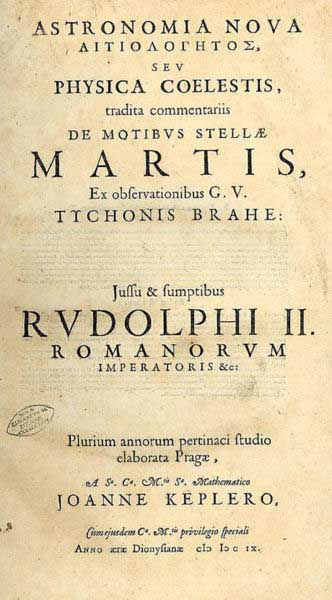|
|
Title Page of Kepler's Astronomia nova (1609 Johannes Kepler's Astronomia nova, published in 1609, contains the results of the astronomer's ten-year long investigation of the motion of Mars. The full title of his work, in English, is New Astronomy, Based upon Causes, or Celestial Physics, Treated by means of Commentaries on the Motions of the Star Mars, from the Observations of Tycho Brahe, Gent. Where previous astronomers had relied on geometric models to explain the observed positions of the planets, Kepler sought for and discovered physical causes for planetary motion. Prior to Kepler, Nicolaus Copernicus proposed in 1543 that the Earth and other planets orbit the Sun. Kepler was the first astronomer to prove this conjecture with rigorous scientific arguments. At over 650 pages in English translation, the Astronomia nova is a lengthy and difficult work from the perspective of a modern reader. Kepler walks his readers, step by step, through his process of discovery so as to dispel any impression of "cultivating novelty," he says. Kepler bases his investigations upon the observations of Danish astronomer Tycho Brahe. Structure of the Astronomia Nova The Astronomia nova unfolds in five parts. In Part I Kepler demonstrates that the three existing geometrical models of planetary motion, of ancient Egyptian astronomer Claudius Ptolemy, his more recent predecessor Nicolaus Copernicus, and Danish astronomer Tycho Brahe are indistinguishable on the basis of observations alone. The three models predict the same positions for the planets in the near term, although they diverge from historical observations, and fail in their ability to predict future planetary positions by a small if measurable amount. In Part I Kepler vigorously investigates Tycho Brahe's data for embedded errors. Kepler also questions the assumption that the Earth or Sun (depending on the model used) moves around the center of its orbit at a uniform rate. He finds that computing critical measurements based upon the Sun's actual position in the sky, instead of the Sun's "mean" position injects a significant degree of uncertainty into the models, opening the path for further investigations. Kepler also demonstrates, in Part II of the Astronomia nova that the prevailing models of planetary motion can not be made to work by simply rebuilding them based on Tycho's more accurate data. The discrepancies he discovers in the reworked models cause him to seek new systems and explanations. Part III of Kepler's work contains his discussion of gravitation, and in Part IV he discovers that the orbit of Mars can not be circular, but must rather describe some sort of oval shape. He subsequently recounts his realization that the shape of the orbit conformed to one of the four conic sections, the ellipse. Part V contains Kepler's conjecture that the Sun is not stationary in space but also follows some orbit across the stars. "Kepler's Laws" The Astronomia nova records the discovery of the first two of the three principles known today as Kepler's Laws These are: 1. That the planets move in elliptical orbits with the sun at one focus(e= c/a); and 2. That the speed of the planet changes at each moment such that the time between two positions is always proportional to the area swept out on the orbit between these positions. Kepler discovered the "second law" before the first. He notices, as recorded in Chapter 32 of the Astronomia nova that the speed of the planet varies inversely based upon its distance from the Sun, and therefore he could measure changes in position of the planet by adding up all the distance measures, or looking at the area along an orbital arc. However, Kepler's "area-time principle" did not facilitate easy calculation of planetary positions. Kepler could divide up the orbit into an arbitrary number of parts, compute the planet's position for each one of these, and then refer all questions to a table, but he could not determine the position of the planet at each and every individual moment because the speed of the planet was always changing. This paradox, referred to as the "Kepler Problem," prompted the development of calculus. "Third law" Kepler discovered his "third law" a decade after the publication of the Astronomia nova as a result of his investigations in the 1619 Harmonices Mundi (Harmonies of the world) He found that the ratio of the length of the semi-major axis of each planet's orbit (squared), to the time of its orbital period (cubed), is the same for all planets. References * Johannes Kepler, New Astronomy, translated by William H. Donahue, Cambridge: Cambridge Univ. Pr., 1992. ISBN 0-521-30131-9 Links * ThinkQuest Challenge- Astronomia Nova * Origins of Modernity- Kepler: Astronomia nova Retrieved from "http://en.wikipedia.org/" |
|


